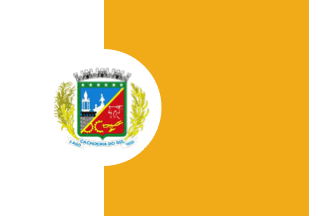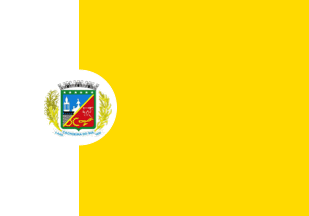 image by Ivan Sache,
13 July 2020
image by Ivan Sache,
13 July 2020
Last modified: 2020-07-14 by ian macdonald
Keywords: rio grande do sul | cachoeira do sul |
Links: FOTW homepage |
search |
disclaimer and copyright |
write us |
mirrors
 image by Ivan Sache,
13 July 2020
image by Ivan Sache,
13 July 2020
The municipality of Cachoeira do Sul (37,352 ha) is located 200 km north of
Porto Alegre. The municipality is composed of the districts of Cachoeira do Sul
(seat); Capané, Barro Vermelho, Três Vendas, Ferreira, Cordilheira and Bosque.
Cachoeira do Sul was settled in 1750 by Portuguese soldiers from São Paulo,
who were granted domains to watch the border with the Spanish colonies. They
were soon joined by farmers from the Azores, where limited arable land could not
afford the increasing population. In 1769, christened Guarani were settled and
used as manpower to build a new settlement, Capela de São Nicolau.
The parish
of São Nicolau da Cachoeira de São José was established on 10 July 1779, to be
subsequently renamed to Nossa Senhora da Conceição. German immigration was
initiated in 1857, followed in 1880 by Italian immigration.
The municipality
of Vila Nova de São João da Cachoeira was established on 26 April 1819,
separating from Rio Pardo, and inaugurated on 5 August 1820. When granted the
rank of "cidade" on 15 December 1859, the municipality was renamed to Cachoeira.
The current name of Cachoeira do Sul was adopted in 1944.
Ivan Sache, 13 July 2020
A vertical bicolour, white-yellow, divided 1:2, with the municipal arms on a white disk on the field boundary.
Official website is at
http://www.cachoeiradosul.rs.gov.br
Dirk Schönberger,
9 January 2012
The flag of Cachoeira do Sul is prescribed by Municipal Law No. 2,009
promulgated on 15 August 1984.
The flag is vertically divided (1:2)
white-yellow, with the municipal coat of arms placed over the flag's vertical
division.
White represents power and peace.
Golden yellow represents the
municipality's main resources, rice and wheat.
The coat of arms represents
the municipal government.
The coat of arms of Cachoeira do Sul, selected
in 1959 in a public contest, is prescribed by Municipal Law No. 1809 promulgated
on 10 December 1959, amended by Municipal Law No. 2,035 promulgated on 5
December 1984.
The shield is surmounted by a three-towered crown, as the
symbol of a "cidade". The green border around the shield represents the
municipality's main source of income, agriculture. The stars argent in the upper
part of the green border represent the districts composing the municipality.
The shield is divided by a golden bend sinister. The upper field, celestial
blue, represents the Catholic origin and quietness of the municipality. It is
charged with stylized representation of the bridge and waterfall symbolizing
Passo de Fandango, Cachoeira's namesake. The lower field, red, symbolizes the
struggle for the borders. It is charged with a golden cogwheel representing
mechanized industry producing agricultural machinery. The golden plow is a
symbol of primitive agriculture practiced in the colonial period. The bovine's
head represents the resources and progress of local cattle-breeders.
The
rice and wheat plants, on the shield's right and left, respectively, symbolize
the municipality's main crops. Beneath the shield, the white writing on a blue
scroll indicates the date of establishment of Vila Nova de São João de Cachoeira,
5 August 1820.
The original coat of arms was slightly modified on 5 December
1984, replacing 8 December by 5 August as the day of establishment.
http://historiadecachoeiradosul.blogspot.com/2011/12/brasao-do-municipio-de-cachoeira-do-sul.html
História de Cachoeira do Sul blog, 9 December 2011
The first quarter
of the coat of arms features Cachoeira do Sul's landmark, the water tower.
Designed by engineers Walter Jobim and Antônio de Siqueira, it was inaugurated
in 1925. The monument is decorated with statues of nymphs and of God Neptune.
https://www.turismo.rs.gov.br/atrativo/43/chateau-d%EF%BF%BDeau#sobre
Turismo Rio Grande do Sul
On the tower's right is represented the central
facade of the Nossa Senhora da Conceição cathedral. The monument is surmounted
by a big statue of the Virgin, c. 4 m in height.
The restoration of the
monument performed in 2017 revealed that the statue does not represent Nossa
Senhora da Conceição but Nossa Senhora das Graças. When revamping the statue,
painters noticed a snake and orb, which are traditional attributes of Nossa
Senhora das Graças. Not upset by the confusion, the inhabitants of the town
"adopted" the new devotional title and said they would be happy to be protected
by two Mary instead by a single one.
https://g1.globo.com/rs/rio-grande-do-sul/noticia/restauracao-revela-que-santa-fixada-em-igreja-de-cachoeira-do-sul-teria-sido-confundida-com-outra-por-80-anos.ghtml
G1, 4 July 2017
Photos
https://www.facebook.com/prefeituracachoeiradosul
https://www.facebook.com/prefeituracachoeiradosul
https://www.jornaldopovo.com.br/anuarios
https://www.facebook.com/prefeituracachoeiradosul
https://www.facebook.com/prefeituracachoeiradosul
https://www.facebook.com/prefeituracachoeiradosul
https://www.facebook.com/prefeituracachoeiradosul
https://www.facebook.com/prefeituracachoeiradosul
https://www.facebook.com/prefeituracachoeiradosul
Ivan Sache,
13 July 2020
Flags used in less
formal contexts appear to have the white field narrower (1:2) and the coat of
arms smaller.
 image by Ivan Sache,
13 July 2020
image by Ivan Sache,
13 July 2020
Photos
https://www.facebook.com/prefeituracachoeiradosul
https://www.facebook.com/prefeituracachoeiradosul
https://www.facebook.com/prefeituracachoeiradosul
Ivan Sache, 13 July 2020